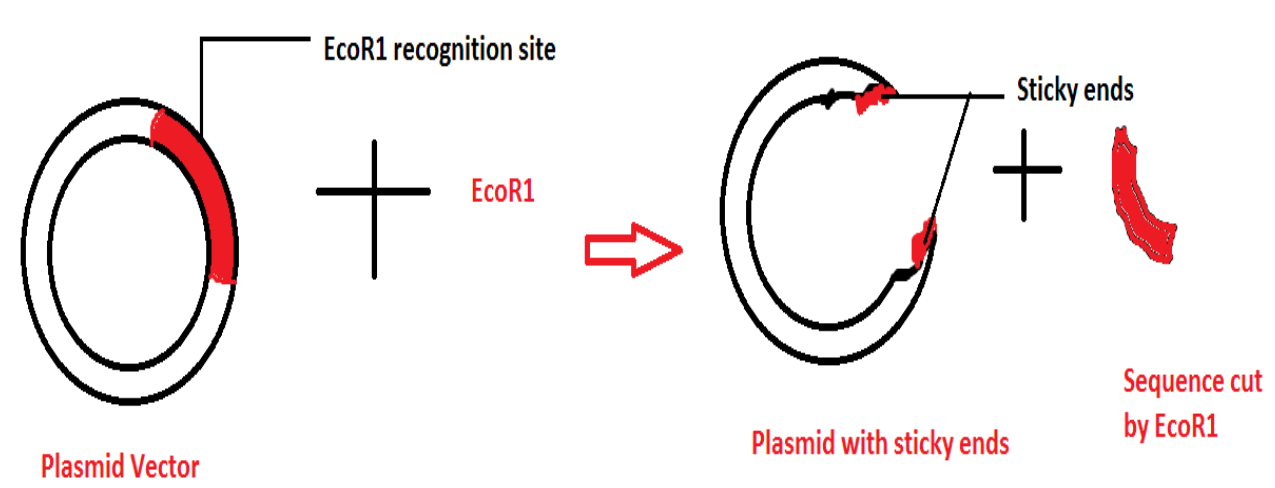
If a plasmid vector is digested with EcoRl at a single site, then
A) One sticky end will be produced
B) Two sticky ends will be produced
C) Four sticky ends will be produced
D) Six sticky ends will be produced
Answer
574.8k+ views
Hint: Plasmid vectors are double stranded circular DNA. They have restriction sites which can be identified by restriction enzymes like EcoRl.
Complete Answer:
- Restriction endonucleases are known as the molecular scissors.
- They are capable of recognising and cleaving a particular DNA sequence. These enzymes are found in bacteria. Plasmids are the vectors which are a circular DNA molecule.
- They have restriction sites in them which can be recognised by the restriction enzymes.
- Plasmids play an important role in recombinant DNA technology. In RDT, the desired site in the circular DNA is cleaved by using restriction enzymes. This results in producing sticky ends. Then the gene to be inserted in the clone is ligated by the help of ligase enzymes.
When a plasmid vector is cut by EcoR1, it results in sticky ends.
- Sticky ends contain certain sequences of nucleotides. EcoR1 produces sticky ends with AATT nucleotide chain.

Thus the correct answer is B. Two sticky ends are produced when EcoR1 cuts the plasmid at one recognition site.
Note: EcoR1 is the restriction enzyme isolated from E.coli. The EcoR1 recognition site is GAATTC. It cleaves the DNA at a single restriction site resulting in sticky ends.
Complete Answer:
- Restriction endonucleases are known as the molecular scissors.
- They are capable of recognising and cleaving a particular DNA sequence. These enzymes are found in bacteria. Plasmids are the vectors which are a circular DNA molecule.
- They have restriction sites in them which can be recognised by the restriction enzymes.
- Plasmids play an important role in recombinant DNA technology. In RDT, the desired site in the circular DNA is cleaved by using restriction enzymes. This results in producing sticky ends. Then the gene to be inserted in the clone is ligated by the help of ligase enzymes.
When a plasmid vector is cut by EcoR1, it results in sticky ends.
- Sticky ends contain certain sequences of nucleotides. EcoR1 produces sticky ends with AATT nucleotide chain.

Thus the correct answer is B. Two sticky ends are produced when EcoR1 cuts the plasmid at one recognition site.
Note: EcoR1 is the restriction enzyme isolated from E.coli. The EcoR1 recognition site is GAATTC. It cleaves the DNA at a single restriction site resulting in sticky ends.
Recently Updated Pages
Why are manures considered better than fertilizers class 11 biology CBSE

Find the coordinates of the midpoint of the line segment class 11 maths CBSE

Distinguish between static friction limiting friction class 11 physics CBSE

The Chairman of the constituent Assembly was A Jawaharlal class 11 social science CBSE

The first National Commission on Labour NCL submitted class 11 social science CBSE

Number of all subshell of n + l 7 is A 4 B 5 C 6 D class 11 chemistry CBSE

Trending doubts
What is meant by exothermic and endothermic reactions class 11 chemistry CBSE

10 examples of friction in our daily life

One Metric ton is equal to kg A 10000 B 1000 C 100 class 11 physics CBSE

1 Quintal is equal to a 110 kg b 10 kg c 100kg d 1000 class 11 physics CBSE

Difference Between Prokaryotic Cells and Eukaryotic Cells

What are Quantum numbers Explain the quantum number class 11 chemistry CBSE




